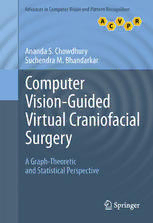Table Of ContentAdvances in Computer Vision and Pattern
Recognition
Forothertitlespublishedinthisseries,goto
www.springer.com/series/4205
Ananda S. Chowdhury (cid:2) Suchendra M. Bhandarkar
Computer
Vision-Guided
Virtual Craniofacial
Surgery
A Graph-Theoretic
and Statistical Perspective
Dr.AnandaS.Chowdhury Prof.SuchendraM.Bhandarkar
DepartmentofElectronics& DepartmentofComputerScience
TelecommunicationEngineering TheUniversityofGeorgia
JadavpurUniversity BoydGraduateStudiesResearchCenter
188RajaS.C.MalikRoad Room415
700032Kolkata,WestBengal 30602-7404Athens,GA
India USA
[email protected] [email protected]
SeriesEditors
ProfessorSameerSingh,PhD Dr.SingBingKang
ResearchSchoolofInformatics MicrosoftResearch
LoughboroughUniversity MicrosoftCorporation
Loughborough OneMicrosoftWay
UK Redmond,WA98052
USA
ISSN2191-6586
ISBN978-0-85729-295-7 e-ISBN978-0-85729-296-4
DOI10.1007/978-0-85729-296-4
SpringerLondonDordrechtHeidelbergNewYork
BritishLibraryCataloguinginPublicationData
AcataloguerecordforthisbookisavailablefromtheBritishLibrary
LibraryofCongressControlNumber:2011923551
©Springer-VerlagLondonLimited2011
Apartfromanyfairdealingforthepurposesofresearchorprivatestudy,orcriticismorreview,asper-
mittedundertheCopyright,DesignsandPatentsAct1988,thispublicationmayonlybereproduced,
storedortransmitted,inanyformorbyanymeans,withthepriorpermissioninwritingofthepublish-
ers,orinthecaseofreprographicreproductioninaccordancewiththetermsoflicensesissuedbythe
CopyrightLicensingAgency.Enquiriesconcerningreproductionoutsidethosetermsshouldbesentto
thepublishers.
Theuseofregisterednames,trademarks,etc.,inthispublicationdoesnotimply,evenintheabsenceofa
specificstatement,thatsuchnamesareexemptfromtherelevantlawsandregulationsandthereforefree
forgeneraluse.
Thepublishermakesnorepresentation,expressorimplied,withregardtotheaccuracyoftheinformation
containedinthisbookandcannotacceptanylegalresponsibilityorliabilityforanyerrorsoromissions
thatmaybemade.
Coverdesign:deblik
Printedonacid-freepaper
SpringerispartofSpringerScience+BusinessMedia(www.springer.com)
To mywifeAnindita
– AnandaS.Chowdhury
To mywifeSwati,son Pranav,and
daughter Asha
– SuchendraM. Bhandarkar
Foreword
Anancientmarinerontheopenseashadtoknowwhereheisbeforehecouldnav-
igate to where he had to go. A surgeon, through training and experience, gains a
mental image of what that “map” should be. It is called surgical anatomy. This is
possiblebecauseforthemostpart,thehumananatomy,atthelarge-scalelevel(1cm
to10cm,forexample),isnotexceedinglyvariable.However,toknowtheprecise
location of the surgery, dissection is needed to allow either direct visualization or
palpationoftheparticularanatomicstructures.Often,suchdissectionisassociated
withdisruptionofnormaltissues,interruptionofbloodsupply,prolongingthemag-
nitude of surgery, increasing the risk of potential complications, and lengthening
thepost-operativeconvalescence.Inrecenttimes,ComputerTomography(CT)and
MagneticResonanceImaging(MRI)haveallowedthesurgeontoseethissurgical
map at a level of detail and precision not previously possible. Recent advances in
both scanning instruments and supporting software have transitioned their impact
frommerelyoutsidetheoperatingroomtoinsidethesurgicaltheater,makingintra-
operative3Dimagingareality.
However, most of the existing intraoperative navigation devices are still bulky,
time-consumingtouse,andincreasethepotentialforcontaminatingthesterileop-
erativefield.Giventhatthecostperminuteintheoperatingroomcontinuestosky
rocket, the more work that can be done before entering the operating room, the
moreeffectiveandefficientthesurgeoncanbe.Thismonographdetailsacollabo-
rative research endeavor over the past five years at the University of Georgia and
theMedicalCollegeofGeorgiaindesigningasoftwaresystemthatcanreconstitute
brokenbonesinsilico,eitherthroughagraphicaluserinterfaceorinanautomated
fashionfromfracturedetectiontofracturereduction—aprocesswherethedisplaced
bone fragments are returned to where they should be. The sizes and shapes of the
fracturedbone(s)andtheshapeoftheinsilicoreconstructioncanbeobtainedand
thenlinkedtoCAD–CAMdevices.Reconstructionplatescanthenbeshapedtofit
precisely the individual anatomy, and the optimal lengths, orientations, and loca-
tionsofthevariousscrewscanbedetermined.Armedwiththiscustomizedfixation
hardware, a surgeon can drastically reduce the time needed in the operating room
and, as long as an accurate fiduciary transfer is made, achieve an accurate reduc-
vii
viii Foreword
tion and fixation of the fractures with significantly less extensive dissection. This
approach improves the current state-of-the-art by increasing accuracy, decreasing
cost,andreducingboththeoperativetraumaandtheriskofoperativeandpostoper-
ativecomplicationstothepatient.
Asapracticingplasticsurgeon,IcanrecallmanytimeswhenIwishedIhadsuch
asoftwaresystematmydisposal.Itwaslargelyonaccountofthispressingneedthat
weembarked,somesixyearsago,uponthisresearchendeavor.Havingtheability
todetectandmanipulatethefracturefragments,andreturnthemtotheirpreinjury
stateinsilicowillallowthesurgeonstoobtainamoreaccuratereductionandrecon-
structionwithlessextensivedissection.Theendresultisamuchshorteroperating
time and significantly improved surgical outcome. This monograph is the culmi-
natingachievementofthesustainedeffortsofmanypeople,especiallyDr.Ananda
Chowdhury,thenaPh.D.candidateattheUniversityofGeorgia,andmydearfriend,
Dr. Suchendra Bhandarkar, Ananda’s doctoral research advisor. It is through such
collaborative work that we can realize significant, high-impact advances that con-
tributetothesurgicaltreatmentofpatientswithcranio-maxillofacialfractures.
JackC.Yu,DMD,MD,MSEd,FACS,FADI
MilfordB.HatcherProfessorofSurgery
andChief
SectionofPlasticSurgery
SchoolofMedicine
MedicalCollegeofGeorgia
Augusta,GA,USA
Preface
Themonographdealswithanimportantapplicationofcomputervisionandpattern
recognitionintheareaofmedicalscience,morespecificallyreconstructivecranio-
facialsurgery.Craniofacialfracturesareencounteredveryfrequentlyintoday’sfast-
pacedsociety;themajorcausesbeinggunshotwounds,motorvehicleaccidents,and
sports-relatedinjuries.Surgicalreconstructionischallengingbecausethesurgeons
in the operating room have to register the broken bone fragments accurately and
under severe time constraints. Within the broad class of craniofacial fractures, the
emphasisinthismonographisonmandibularfracturessincethemandibleisoften
unprotectedandexposedmakingitespeciallyvulnerabletoaccidentsandinjuries.
Atypicalinputtoacomputervision-basedsystemforvirtualcraniofacialsurgeryis
asequenceofComputedTomography(CT)imagesofafracturedhumanmandible.
ThedetectionoffracturesinCTimages,theotherintegralcomponentofreconstruc-
tivecraniofacialsurgery,isoftendifficultbecauseofthecomplexityofthefracture
patterns,missingdata,imageintensityinhomogeneities,andpresenceofnoiseand
undesiredartifacts.
A formal treatment of computer vision-guided craniofacial surgery entails the
solvingoftwobroadclassesofproblems,i.e.,computer-aidedfracturedetectionand
virtualreconstruction,bothofwhichraiseseveralimportanttheoreticalandpractical
issues. From a theoretical standpoint, the monograph discusses several traditional
topicsincomputervisionandpatternrecognitionsuchasimageregistration,image
reconstruction,combinatorialpatternmatching,anddetectionofsalientpointsand
regionsinanimage.Severalusefulalgorithmsandconceptsfromtwotraditionally
diverse disciplines, namely, graph theory and statistics are seen to be applicable
in this context. The relevant topics from graph theory include maximum-weight
graph matching, maximum-cardinality minimum-weight matching for a bipartite
graph, maximum-flow minimum-cut determination in a flow graph, and construc-
tionofautomorphsofacyclegraph.Themonographdemonstrateshowtheabove
graph-theoreticalgorithmscanbeappliedtosolvesomeimportantproblemsincom-
putervisionandpatternrecognitionthatpertaintovirtualreconstructivecraniofacial
surgery.ThevariousstatisticaltechniquesbroughttobearincludeMarkovrandom
fields, hierarchical Bayesian restoration, Gibbs sampling, and Bayesian inference.
ix

